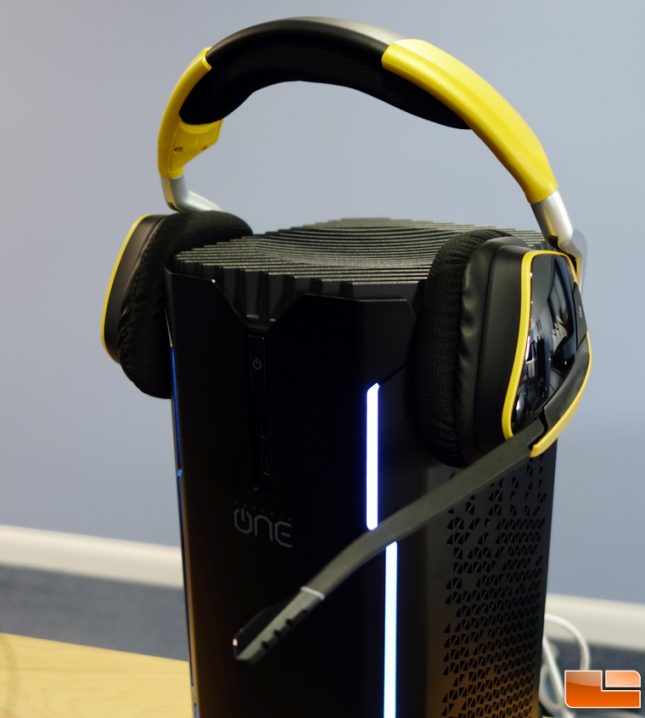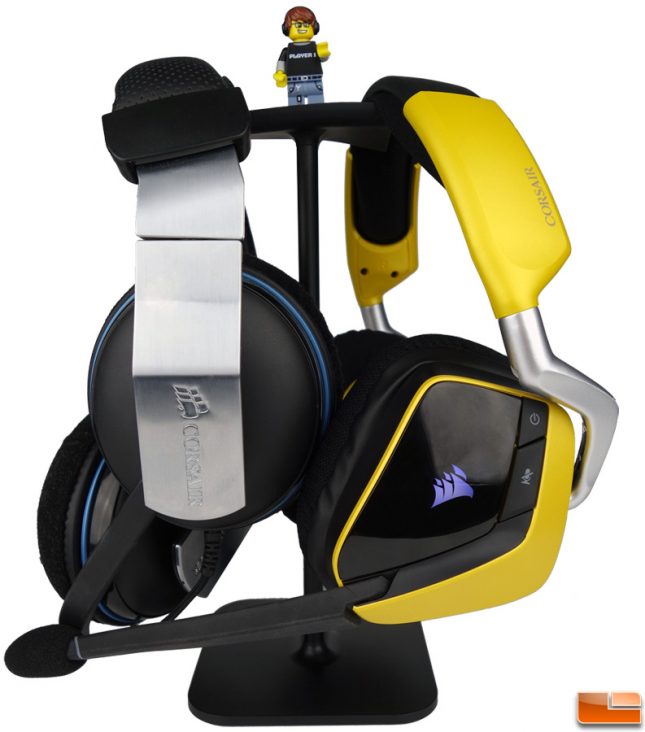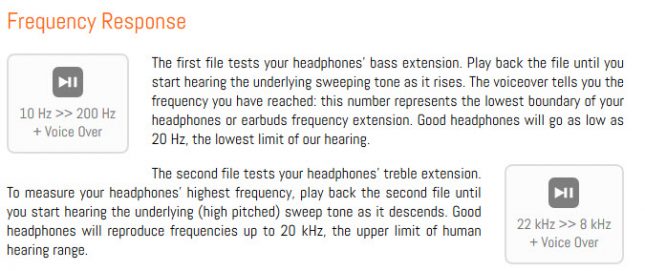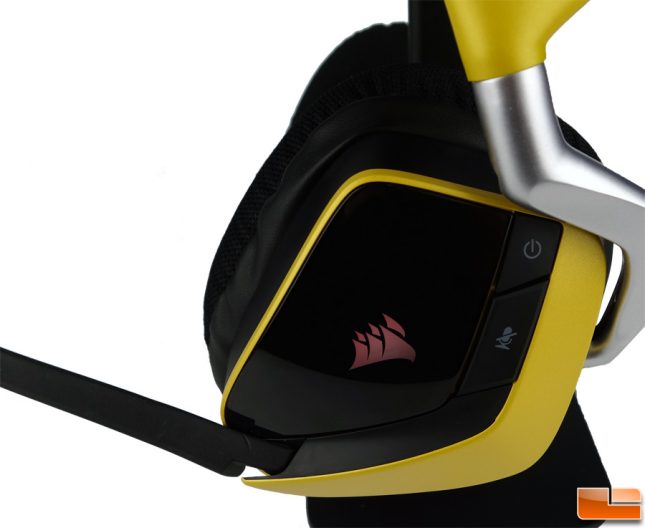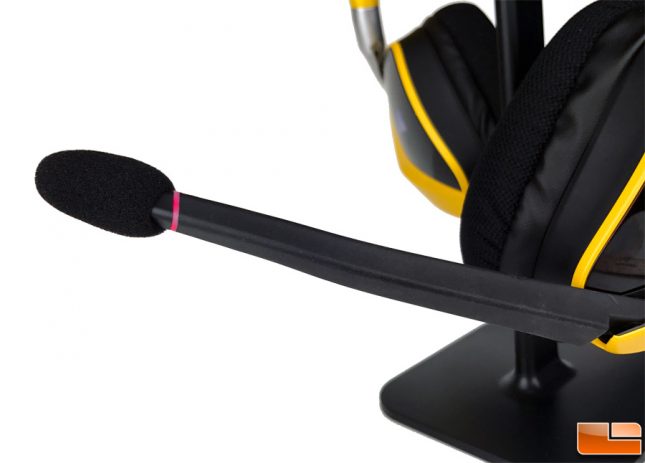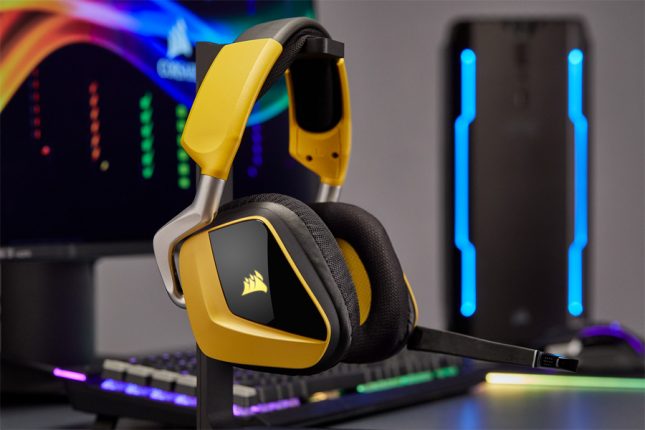Corsair VOID PRO RGB Wireless SE Gaming Headset Review
Corsair Void Pro SE RGB Headset Use and Final Thoughts
As mentioned early on the Corsair Void Pro Wireless headset (this being the SE version) is quite handsome and checks all the boxes one would be consulting a wish list of items in a gaming headset. It’s attractive, has great sound – 7.1 Dolby no less, is wireless, and comfortable to use over long periods. Some may take exception to the wireless part being desirable in gaming headset because of a bias of opinion towards lag but none could be found here. The 2.4GHz wireless connectivity worked flawlessly from well over 30 feet away and through walls no less. It uses automatic frequency hopping to constantly find the optimal signal which worked very well given the amount of 2.4GHz interference I have around the house with amount of home automation gadgets I have scattered throughout. Honestly, this was an area I was concerned about going in. The added flexibility of an extensible dock for the transmitter only helped disabuse the notion that wireless headsets unreliable at a distance. In fact, the majority of time I used it, I simply plugged the USB dongle directly into an available USB port and never had to give it another thought. I never felt like the audio quality was compromised by the signal. When the signal dropped, it dropped altogether like cell phones do. No static or distortion, just dead air. I had to walk pretty far around multiple corners from my office to finally get it to drop off.
The sound quality is excellent, whether slogging it out in a game, listening to a movie, or jamming out to some tunes. I actually found a cool website that gives a slew of audio samples in various frequencies for testing audio equipment. Much of it is very much like the hearing tests you get at the doctor’s office during a physical (PSA – if you aren’t getting an annual physical – especially those getting up there in age, please schedule one…we would like our readers to remain healthy and stick around!). If you are to try out the various tests on the aforementioned site, pay close attention to the 10 Hz >> 200 Hz range and bass shaker tests. If turned up loud, this is where lesser quality speakers will begin to sound distorted (if they can even reproduce the sound at all) but I’m happy to report none of that was experienced with the Void Pro. In fact, all of the test sounded great. The Binaural Test – the one where it’s a knocking sound – scared the bejesus out of me because I literally thought someone knocked on the wall next to me and I was home alone at the time. I should’ve thoroughly read the description first! If you find the audio test site useful, consider making a donation (Disclaimer – we have absolutely no affiliation or vested interest with the site, it’s creator, and/or owner). It does take time and effort to maintain a site, not to mention hosting costs, etc. so be considerate. As a donor, you’ll receive access to files for use off-line as a bonus on top of the satisfaction of being a good interweb citizen. In full disclosure, I did make a personal monetary donation.
Using the CUE software to tune the EQ, I was able to get very good bass response without muddying the sound too much (this tends to be an issue with sub par speakers) and the 7.1 surround worked well, helping me identify potential enemies lurking about outside my field of view and giving good aural immersion while watching movies. My much older Vengeance 1500 headset, which I’ve used for years, sounded tinny in comparison so any guesses as to which one will be my go to headset going forward? As mentioned, I personally felt the fit was somewhat loose and had the tendency to shift with rapid head movement. When I queried Corsair, they chalked it up to the softness of the viscoelastic memory foam. It’s also likely they were consciously avoiding an overly tight fit which can definitely lead to premature wear fatigue. Being that one doesn’t do a lot of head shaking when gaming unless unnecessarily hyperactive or prone to ego spasms upon various achievements, I’ll take the comfort part of that equation any day. I really did forget I was wearing these even after a handful of hours, thanks to the microfiber mesh cloth and memory foam which speaks volumes to their comfort. Upon reflection, perhaps I’ve been wearing my headsets too tight all this time? I found that “loose” feeling abated over time though they can still be dislodged with a not so subtle shake of the head. These aren’t the lightest headsets on the market but not heavy by any stretch so that never factored into my perceived comfort. At the end of it all, yes they still feel a little loose on the head to me but I definitely think that plays into their comfort on the positive side so I won’t exactly pan Corsair for their design in this respect.
Also as mentioned, the RGB lighting has a smorgasbord of color combinations available in a number of patterns but even on the brightest setting the lighter hues tended to be washed out a bit when there’s a fair amount of ambient light. Not all that unusual for some RGB products and given brighter = less battery life, I can’t really complain about it. I did notice that when setting to any of the patterns that leverage some sort of blinking in he CUE software, with no audio actually playing, there was an ever so slight tone that could be heard as a result of the lighting that occurred every time the light pulsed on. Again, this was ever so slight and it was dead quiet in the room otherwise, so nothing you would notice with sound of any sort coming through the speakers. I just so happened to hear it when playing with the RGB lighting after first receiving them and not having another RGB capable headset to compare to, I can’t say if this is unusual or not. Personally, I’d leave the RGB off altogether to maximize battery life, which indeed I did and found that it lasted me the rated 16 hours with no problem.
In addition to being comfortable, they feel quite stout in the way of build quality which is excellent and at no point in any of the fixed or articulating pieces do they give a sense of fragility. The PA6 glass infused fiber plastic doesn’t give a hint of flex. I didn’t exactly drop them down concrete stairs or throw them in a blender but I banged them around a bit to see if I could maybe douse the RGB lighting and to my (and I’m sure Corsair’s) delight, they came away no worse for the wear and continue to function as they did when I freed them from the confines of the packaging. I guess you could say they took a knocking and kept on rocking.
At $129.99 for the yellow jacket SE versions of the Void Pro headsets, it pushes the high-end of what one can expect to pay for the top tier gaming headsets on the market but if the extended transmitter dock and yellow color don’t exactly ring your bell, you can save $30 by going with the white or carbon version for just $99.99. For those that would like pricing to even come down a step further, one of the non-wireless (RGB or 3.5mm surround) version kicks it down to $79.99 which carries most of the same specs except as noted in the table on the first page of this article. However, I can tell you that freedom from wires on a headset is awesome and I didn’t realize what a pain wires are was until using these so call me a convert. In the end, the most crucial criteria in the formula for success of a gaming headset is comfort and sound quality. I think Corsair nailed those and then added to it great things like wireless, RGB lighting, superb microphone performance, durability, and aesthetics. What’s not to like?
Legit Bottom Line: If you’re in need of a quality 7.1 surround gaming headset and wires are something you’d rather do without, the Corsair Void Pro has a perfect fit for your needs and if indifferent about being tethered, they have some of those too – along with some cost avoidance for skipping the wireless components.

